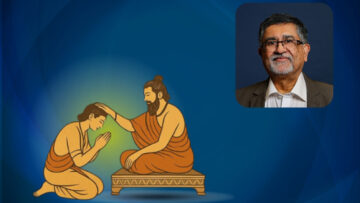“When you test the force above us, you must be prepared to face what is coming your way…. When you want to test her, don’t forget that you won’t be able to withstand it if she does the same thing back to you. She showers love on her children, but never undermines her compassion”
— A devotee of Draupadi Amman, Theemithi Festival
These powerful words come from a devotee of Draupadi Amman, a goddess deeply respected in South Indian and Tamil traditions. She is not just a queen from the Mahabharata. For her followers, she is a living symbol of strength, justice, and sacrifice. Every year, people honour her through a bold ritual called Theemithi, where they walk barefoot over burning coals.
As the firewalkers step out of the burning embers, the assembled crowd chants, “Draupadi Ammanukku Arogara,” which means “Hail to Mother Draupadi.” The ritual is seen as a mark of devotion, undertaken in fulfilment of vows or to seek blessings.
But what makes men walk through fire in the name of a woman from an ancient epic? Who is this Draupadi whom thousands worship not just as a queen from an epic, but as a living goddess?
Draupadi Amman
The transformation of Draupadi from an epic queen to a Goddess revered in Tamil folklore
Amman – A Tamil word meaning “mother” or “goddess.” It is commonly used to refer to local female deities who are seen as protectors and healers. Draupadi Amman means “Mother Draupadi” or “Goddess Draupadi”
Born from the sacred fire of a yajna, Draupadi emerges in the saga of Mahabharata not as an ordinary woman, but as a force destined to challenge injustice. As queen of the Pandavas, her public humiliation in the Kaurava court becomes one of the epic’s most defining moments. Refusing silence, she demands justice.
In Tamil folk tradition, it is believed that after the Kurukshetra war, Draupadi walked through fire (Agni Pariksha) to prove her chastity and inner purity. Although this episode is not found in most classical versions of the Mahabharata, it plays a central role in her worship in Tamil Nadu.
The central act of firewalking during the Theemithi festival symbolically reenacts this episode, with male devotees walking across burning embers in her honour. The ritual is widely regarded as an act of devotion, undertaken in fulfilment of vows or as a plea for divine intervention, where only the “pure” are believed to emerge unscathed.
Draupadi’s divine image grows stronger through Therukoothu, a lively form of street theatre that retells key moments from the Mahabharata. Scenes of her humiliation, her fierce vow for justice, and the great war play out over several nights, turning village squares into open-air stages of devotion. Many temples devoted to Draupadi Amman also follow a three-month cycle of rituals. Priests and devotees recite the Mahabharata chapter by chapter, offer daily worship, and prepare for the final event, the Theemithi fire-walking ceremony. When the embers are laid out and the first devotee steps across, story and ritual come together, fixing Draupadi’s memory in the hearts of everyone watching.
In Tamil life, Draupadi Amman is far more than a queen from ancient scriptures. She is a guardian, a moral compass, and a living symbol of shakti, the power that rises from within every woman. Her festivals are filled with flame, music, and shared faith. They turn myth into everyday reality. Theemithi is not just a ritual act. It is a public vow that justice and feminine strength will always have the last word.
Theemithi Festival
Theemithi or the fire walking festival is Hindu festival that originated in Tamil Nadu and has since extended to regions with significant Tamil diaspora populations including Sri Lanka, Malaysia, Singapore, South Africa, and Mauritius. It is observed in the Tamil month of Aippasi (October to November), approximately a week before Deepavali, the festival spans nearly two and a half months during which a series of devotional rituals are carried out. In Singapore, the ritual begins at the Sri Srinivasa Perumal Temple and ends at the Sri Mariamman Temple in Chinatown, where the fire-walk takes place, typically a week before Deepavali.
(Figure 1: Sri Srinivasa Perumal Temple, Singapore)
At the centre of Theemithi is the worship of Draupadi Amman, who is venerated as a Grama Devata, or village guardian deity, in many Tamil communities.
In Tamil folk tradition, Draupadi from the Mahabharata is believed to be an incarnation of Mariamman, a pre-Vedic goddess associated with rain, healing, and protection from diseases such as ammai (smallpox) and vyapam (fever). The fiery strength and maternal grace of Mariamman are seen as embodied in Draupadi, whose epic suffering and endurance make her a powerful goddess figure in Tamil rural religion.
Theemithi begins with kodi etram, the ceremonial hoisting of a saffron flag at the temple to mark the start of the festival. In the weeks that follow, priests and lay readers gather nightly to recite the Mahabharata, especially the episodes that highlight Draupadi’s humiliation, her vow for justice, and her unwavering spiritual resolve. These readings prepare devotees mentally and emotionally while weaving the epic into the rhythms of everyday life.
Midway through the festival, village streets come alive with Therukoothu, traditional folk theatre performances that reenact key episodes from Draupadi’s life. These include her marriage to the Pandavas, the dice-game humiliation, and scenes from the Kurukshetra war. These performances do more than entertain; they act as communal prayers, blessing the ground and the people gathered there. They are sacred storytelling, intended to honour Draupadi and invoke her presence.
(Figure 2: An artist performing Therukoothu)
During this time, devotees take personal vows, signified by tying a turmeric-stained thread called kappu around their wrist. Some undertake rituals like paal kudam, carrying pots of milk, or kumbidu thandam, where they perform full-body prostrations along temple paths. In the final ten days, participants engage in purificatory practices such as fasting, abstaining from alcohol and meat, bathing in temple tanks at dawn, and sleeping on the floor. These acts are believed to purify the body and mind and prepare the devotee for Draupadi’s grace and protection.
The firewalk, also called Poo Methippu, meaning “flower stepping,” takes place just before sunrise. The glowing embers are seen as orange blossoms, a poetic expression of the Tamil aesthetic where beauty and devotion are closely intertwined. A trench is filled with hardwood embers, and the temple priest walks across first while balancing a karakam, a brass pot filled with consecrated water, on his head. Behind him follow the vow-keepers, mostly men, who walk across the burning coals barefoot. Each step is an act of faith, gratitude, or petition. It is widely believed that those who are sincere complete the walk without injury, shielded by the blessings of Draupadi Amman.
Then comes the central act of the festival is the neruppu nadakkam, or firewalking, where devotees walk barefoot across burning embers. This act is performed as a fulfilment of personal vows, known as vratam, or as an offering of gratitude and devotion to Draupadi Amman.
At the end of the path, the participants cool their feet in milk or sacred water, symbolising purification and closure. They then enter the sanctum to offer coconuts, lamps, and flowers to Draupadi. The priest blesses the gathered crowd by sprinkling holy water from the karakam, sharing the sanctity of the moment with everyone present.
Theemithi concludes with Thirukkappu, the ritual lowering of the flag, signalling the end of the sacred cycle. What began with an epic memory now returns the community to its daily life, renewed through fire, devotion, and collective faith.
Theemithi therefore becomes much more than a religious festival. It is a ritual space where epic, folklore, and local goddess worship converge, transforming Draupadi from an epic heroine into Amman (Mother), who continues to walk with her people
Symbolism of Fire in Hindu Thought
In Hindu thought, fire (agni) is not merely an element; it is a living force, both purifying and consuming. As a divine witness (Agni Dev), fire appears in sacred rituals from weddings to funerals, believed to cleanse, test, and transform. Within this framework, Theemithi takes on deeper symbolic meaning. Fire becomes a trial of truth, a path walked not just by the body but by the soul seeking communion with the divine.
The idea of fire as a purifier resonates across Hindu mythology. The tale of Sita’s Agni Pariksha in the Ramayana portrays fire as a divine judge of chastity. Similarly, Tamil folklore holds that Draupadi, after the Kurukshetra war, walked through fire to prove her purity and divinity.
The Line Between Faith And Fanaticism?
Theemithi rests on a thin line between faith and fanaticism. Medical professionals warn of burns, infections, and exhaustion. Activists question whether all participants act freely or under social pressure. When suffering is ritualised, critics ask at what point devotion risks becoming blind submission.
Yet, to many devotees, it is not an act of fanaticism but a profound philosophical offering. The firewalk becomes a test not of physical endurance alone but of spiritual sincerity. They see the flames as mirrors of life’s trials. Walking through them is not about pain but about purification, where belief is not imposed but fully embodied.
Theemithi continues to thrive both in Tamil Nadu and in Tamil diaspora communities like Singapore, Malaysia, and South Africa. While concerns about commercialisation exist, many young people remain connected through temple volunteering, cultural education, and performance traditions like Therukoothu. Temples have introduced safety measures and community outreach to preserve the ritual’s meaning. Draupadi is also being reinterpreted by feminists and artists as a symbol of strength and justice. Today, Theemithi lives not just in fire-walking, but in storytelling, memory, and cultural identity. Across generations, the ritual endures as both a sacred act and a living expression of heritage.
Theemithi is not only a personal act of faith. It reflects a deeper belief rooted in Tamil folklore that Draupadi herself walked through fire after the war of Kurukshetra, proving her purity and divine nature. While this episode is absent in many classical texts, it lives on through ritual. The reading of the Mahabharata, the use of sacred water, the priest’s leadership, and the presence of the whole community turn this tradition into a living memory of courage, justice, and spiritual strength.
References
Dhaara Magazine. (2020, November 7). Thimithi: This fire-walking festival celebrates Draupadi’s “purity”. Dhaara. https://dhaaramagazine.in/2020/11/07/thimithi-this-fire-walking-festival-celebrates-draupadis-purity/
Outlook Traveller. (n.d.). In Tamil Nadu’s Thimithi festival, worshippers walk on fire. Outlook Traveller. https://www.outlooktraveller.com/explore/culture/in-tamil-nadus-thimithi-festival-worshippers-walk-on-fire
Madhu, N. (n.d.). Theemithi: A celebration of feminine divinity and the legend of Draupadi. Goa University NAAC Repository.
https://naac.unigoa.ac.in/criterion1/1.3.4-Namrata-Madhu.pdf
National Library Board Singapore. (2022). Walking on fire: The Theemithi festival. BiblioAsia, 18(3).
https://biblioasia.nlb.gov.sg/vol-18/issue-3/oct-dec-2022/theemithi-firewalking-festival/
Feature Image Credit: nativeplanet.com
Disclaimer: The opinions expressed in this article belong to the author. Indic Today is neither responsible nor liable for the accuracy, completeness, suitability, or validity of any information in the article.










